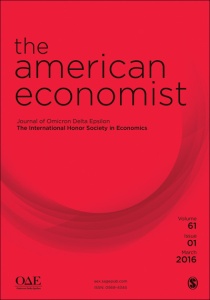The American Economist is Now Accepting Submissions!
 You can now submit electronically to The American Economist through SAGE Track!
You can now submit electronically to The American Economist through SAGE Track!
As an official publication of Omicron Delta Epsilon, The International Honor Society in Economics, The American Economist strives to contribute to the ongoing dialog and academic debates within the economics discipline by publishing original research and review articles from all fields and schools of economic thought. Published twice a year in the Spring and the Fall, the journal has honored academic achievement in economics for more than fifty years.
The American Economist specifically encourages submissions from young scholars and those who are teaching the next generation of economists, and will continue to publish papers from experienced and prominent economists whose influence has shaped the discipline.
Manuscript Guidelines
The paper should include five keywords and an abstract of about 100 words, which will be used on the web to describe the article. Articles that have already been published elsewhere cannot be considered. All submissions are single-blind reviewed. Articles regarding all areas of economics and its related fields are appropriate for submission. Submitted articles should not exceed twenty-five pages in length.
- A title page should include article’s title and the author’s name and affiliation. Address details should be brief, including telephone number and e-mail.
- The text of the article should include section headings (designated by Roman numerals—I, II, III. . .), and subsection headings (Arabic numbers—1,2,3. . .). References to sources should be in the following form: (Jones 2003, 12–16).
- Please do not use any footnotes, rather put all notes immediately following your article. Numbering should be done using the standard Arabic number system (1,2,3, etc.).
- Please do not use any handwritten or typed figures and equations. All equations should be computer generated, and alike in proportion. The authors are responsible for providing copies of their charts, graphs, and tables and have them numbered consecutively in the text in Arabic numerals and also provided on separate sheets.
- References should follow the Notes section at the end of the article.
- Bibliographic citations should follow ASA style guidelines.
- The American Economist holds the copyright to all its published articles.
You can submit now by clicking here!
Make sure to watch for more from The American Economist in 2016!



























































































